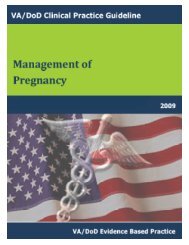DM Full Guideline (2010) - VA/DoD Clinical Practice Guidelines Home
DM Full Guideline (2010) - VA/DoD Clinical Practice Guidelines Home
DM Full Guideline (2010) - VA/DoD Clinical Practice Guidelines Home
Create successful ePaper yourself
Turn your PDF publications into a flip-book with our unique Google optimized e-Paper software.
Version 4.0<br />
EVIDENCE<br />
- Take Charge of Your Diabetes: Prevent Foot Problems<br />
- Taking Care of Your Feet<br />
- Tips on Good Foot Care: from Feet Can Last a Lifetime<br />
<strong>VA</strong>/<strong>DoD</strong> <strong>Clinical</strong> <strong>Practice</strong> <strong>Guideline</strong><br />
for the Management of Diabetes Mellitus<br />
Recommendation Sources LE QE SR<br />
1 Patient education on specific<br />
aspects of care.<br />
ADA, 2002<br />
Litzelman et al., 1993<br />
III<br />
I<br />
Fair<br />
B<br />
Young et al., 1992<br />
III<br />
2 Patient instruction on self-foot<br />
care.<br />
Ahroni, 1993<br />
Barth et al., 1991<br />
III<br />
II<br />
Fair<br />
B<br />
Fain & Melkus, 1994<br />
II<br />
Feste, 1991<br />
III<br />
Mayfield et al., 1998 [SR]<br />
II<br />
Weir et al., 1994<br />
III<br />
QE = Quality of Evidence; R = Recommendation; SR = Systematic Review (see Appendix A).<br />
I. Perform Visual Inspection and Peripheral Sensation Evaluation At Each Routine Primary Care<br />
Visit<br />
OBJECTIVE<br />
Ensure ongoing screening to identify patients at risk for LE ulcers and amputation.<br />
RECOMMENDATIONS<br />
1. Visual inspection and peripheral sensation testing in high-risk patient should be performed at each routine<br />
primary care visit for all patients (see Annotation A).<br />
J. Perform Wound Assessment<br />
OBJECTIVE<br />
Determine the character and nature of the wound.<br />
RECOMMENDATIONS<br />
1. Patients with diabetes with minor wounds or foot lesions should have a wound assessment.<br />
2. The wound assessment includes:<br />
• A review of anatomic, physical, and lesion characteristics including determination of circumference,<br />
depth, and involvement of deep structures.<br />
• Assessment for signs of infection including necrosis, sinus tracts, exudate, odor, presence of fibrin, and<br />
healthy granulation tissue.<br />
• Assessment of surrounding areas for signs of edema, cellulitis, or abscess.<br />
Module F – Foot Care Page 103
















